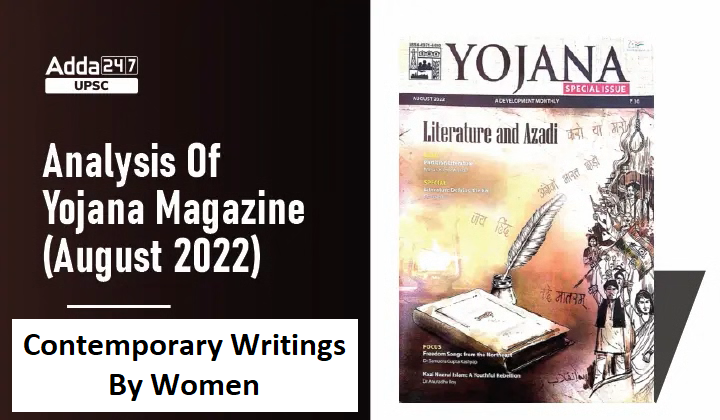Table of Contents
Yojana Magazine is a very important and indispensable source for UPSC Civil Services Exam Preparation. Here, we come with ”Analysis Of Yojana Magazine” which covers the monthly Yojana Magazine keeping in mind the demand of UPSC, particularly from the topics of important government schemes.
In ‘‘Analysis Of Yojana Magazine,” we cover each and every topic of the Yojana edition of a particular month and provide an easy-to-understand gist.
This topic-wise analysis is prepared from the August 2022 edition of the monthly Yojana Magazine.
Introduction
- Women had eager and sincere participation in India’s struggle for freedom, but the leadership was in the hands of men only.
- Yet, this period is extremely significant as the “beginning of freedom” for women.
- The foundation for this movement had been laid in the anti-British Raj days when women had started discovering their identity through literature.
- They slowly became part of the world’s women’s movement and their role in the social and political movements in their own country started becoming more and more prominent.
- In the post-independence period women concentrated on their own freedom.
Women’s voices in Partition literature
Women Before 1992
- Novels like Jyotirmoyee Devi’s Epar Ganga Opar Ganga (1968)
- Amrita Pritam’s Punjabi poem “Aaj Aakhaan Waris Shah Nu (Today I Invoke Waris Shah)
Women After 1992
- Developed after around 50 years of Independence, a new wave of feminist perspective emerged.
- Examples of Feminist Partition Literature:
- Urvashi Butalia – ‘The Other Side of Silence: Voices from the Partition of India’
- Ritu Menon and Ritu Memon – ‘Border and Boundaries’
- Jasodhara Bagchi – ‘Trauma and Triumph’
- Bapsi Sidhwa’s novel Ice Candy Man (1992)
- Sunanda Sikdar’s Partition memoir Doyamoyeer Kotha (translated into English as A Life Long Ago)
- Pakistani historian Anam Zakaria, who has written two books about partitions in the Indian subcontinent: The Footprints of Partition: Narratives of Four Generations of Pakistanis and Indians (2015) and 1971: A People’s History from Bangladesh, Pakistan and India (2019).
- Pakistani author Khadija Mastoor’s Urdu novel ‘Aangan’
What do we know from pre-independence women’s writings?
- The analysis of women’s autobiography helps to bring to the fore her society, community, agony, trauma, experiences of gender difference, and psychosocial and language expressions.
- The autobiography of Begum Sultan Jahan of Bhopal has details on colonial power, the rise of nationalist ideology, and socio-religious reform movements.
- Shah Jahan Begum wrote Tehzeeb-un-Niswan-oTarbiyet-ul-insaan to teach women how to conduct themselves.
- These autobiographies provide a view of the cultural context and history in the changed circumstances following the partition and the dimensions of their association with gender issues.
- They have mentioned social and family compulsions on being a woman, gender politics and censorship.
- In 1882, Tarabai Shinde’s book, Stree Purush Tulana generated heated discussions all over. She insisted that the faults, commonly ascribed to women, such as superstition, suspicion, treachery and insolence, could be as much found in men. She suggested to the women that, by the strength of their firm will, they remain always well behaved, pure as fire and unblemished internally and externally. Tarabai also suggested that men would have to hang their heads down in shame.
- The autobiography of Begum Qudsia Aizaz Rasool titled ‘From Purdah to Parliament’ gains importance as it shows the potential of women with leadership abilities in a patriarchal society.
- She served as the Deputy President of the Council from 1937 to 1940. She was the first Indian Muslim woman to reach such a high position.
What do we know from Post Independence women’s writings?
- Women’s autobiographies in the post-independence period depict how society views women and vice versa, and what do women think of the socio-political changes around them.
- The role of social transformations and the desire for women’s emancipation can be seen in the autobiographies of women who migrated to Pakistan.
- They appear to be trying to liberate themselves but also want to create their own identity in society.



 TSPSC Group 1 Question Paper 2024, Downl...
TSPSC Group 1 Question Paper 2024, Downl...
 TSPSC Group 1 Answer key 2024 Out, Downl...
TSPSC Group 1 Answer key 2024 Out, Downl...
 UPSC Prelims 2024 Question Paper, Downlo...
UPSC Prelims 2024 Question Paper, Downlo...





